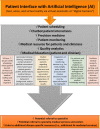Artificial intelligence and obesity management: An Obesity Medicine Association (OMA) Clinical Practice Statement (CPS) 2023
- PMID: 37990659
- PMCID: PMC10662105
- DOI: 10.1016/j.obpill.2023.100065
Artificial intelligence and obesity management: An Obesity Medicine Association (OMA) Clinical Practice Statement (CPS) 2023
Abstract
Background: This Obesity Medicine Association (OMA) Clinical Practice Statement (CPS) provides clinicians an overview of Artificial Intelligence, focused on the management of patients with obesity.
Methods: The perspectives of the authors were augmented by scientific support from published citations and integrated with information derived from search engines (i.e., Chrome by Google, Inc) and chatbots (i.e., Chat Generative Pretrained Transformer or Chat GPT).
Results: Artificial Intelligence (AI) is the technologic acquisition of knowledge and skill by a nonhuman device, that after being initially programmed, has varying degrees of operations autonomous from direct human control, and that performs adaptive output tasks based upon data input learnings. AI has applications regarding medical research, medical practice, and applications relevant to the management of patients with obesity. Chatbots may be useful to obesity medicine clinicians as a source of clinical/scientific information, helpful in writings and publications, as well as beneficial in drafting office or institutional Policies and Procedures and Standard Operating Procedures. AI may facilitate interactive programming related to analyses of body composition imaging, behavior coaching, personal nutritional intervention & physical activity recommendations, predictive modeling to identify patients at risk for obesity-related complications, and aid clinicians in precision medicine. AI can enhance educational programming, such as personalized learning, virtual reality, and intelligent tutoring systems. AI may help augment in-person office operations and telemedicine (e.g., scheduling and remote monitoring of patients). Finally, AI may help identify patterns in datasets related to a medical practice or institution that may be used to assess population health and value-based care delivery (i.e., analytics related to electronic health records).
Conclusions: AI is contributing to both an evolution and revolution in medical care, including the management of patients with obesity. Challenges of Artificial Intelligence include ethical and legal concerns (e.g., privacy and security), accuracy and reliability, and the potential perpetuation of pervasive systemic biases.
Keywords: Adiposopathy; Artificial intelligence; Education; Obesity.
© 2023 The Authors.
Figures














References
-
- Lee P., Bubeck S., Petro J. Benefits, limits, and risks of GPT-4 as an AI chatbot for medicine. N Engl J Med. 2023;388:1233–1239. - PubMed
-
- Leucutia T. Heuristic glimpses into the evolution of radiation therapy; particularly in reference to gynecologic cancers. Am J Roentgenol Radium Ther Nucl Med. 1961;85:3–20. - PubMed
-
- Maron M.E. Artificial intelligence and brain mechanisms. MEM RM-3522-PR. Memo RM. 1963;86:1–35. - PubMed
-
- Matsunaga T., Muramatsu M.A. Knowledge-based computational search for genes associated with the metabolic syndrome. Bioinformatics. 2005;21:3146–3154. - PubMed
LinkOut - more resources
Full Text Sources

